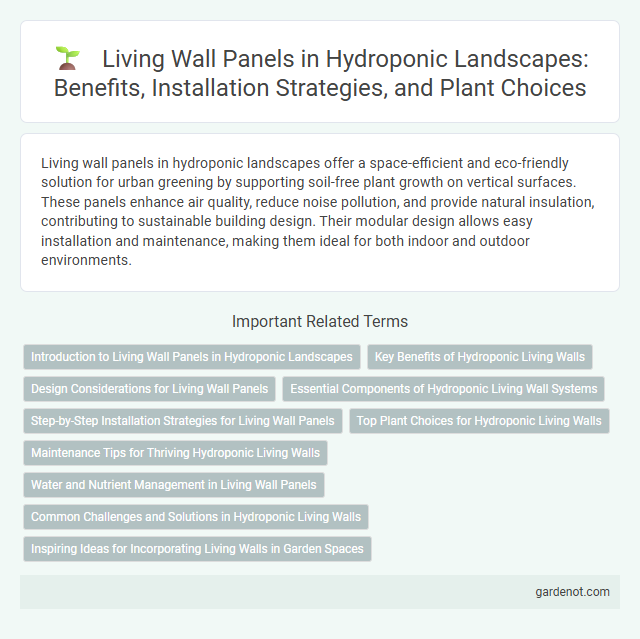Living wall panels in hydroponic landscapes offer a space-efficient and eco-friendly solution for urban greening by supporting soil-free plant growth on vertical surfaces. These panels enhance air quality, reduce noise pollution, and provide natural insulation, contributing to sustainable building design. Their modular design allows easy installation and maintenance, making them ideal for both indoor and outdoor environments.
Introduction to Living Wall Panels in Hydroponic Landscapes
Living wall panels in hydroponic landscapes offer a soil-free, vertical gardening solution that maximizes space efficiency and promotes sustainable urban greenery. These panels integrate advanced hydroponic systems with modular structures, enabling precise nutrient delivery and water conservation while supporting diverse plant species. Optimized for both indoor and outdoor environments, living wall panels enhance air quality, provide thermal insulation, and create visually striking, eco-friendly spaces.
Key Benefits of Hydroponic Living Walls
Hydroponic living walls enhance urban environments by improving air quality through natural filtration and increasing oxygen levels. These vertical gardens optimize space usage, making them ideal for limited areas while promoting biodiversity and reducing urban heat effects. Maintenance efficiency is boosted by automated water and nutrient delivery systems, reducing resource consumption and supporting sustainable landscaping practices.
Design Considerations for Living Wall Panels
Living wall panels in hydroponic landscapes require careful design considerations including plant selection, irrigation systems, and panel material durability. Optimal plant choices must suit vertical growth and microclimate conditions, while efficient drip irrigation or nutrient film techniques prevent water waste and promote healthy root systems. Panel materials should be lightweight, corrosion-resistant, and allow adequate air circulation to support sustainable hydroponic living walls.
Essential Components of Hydroponic Living Wall Systems
Hydroponic living wall panels integrate essential components such as a durable frame, a growth medium like felt or rock wool, and a network of water delivery tubes for efficient nutrient distribution. A well-designed irrigation system with drip emitters ensures consistent moisture levels, while a reservoir and pump maintain nutrient solution circulation, preventing root dehydration. Sensors for pH, moisture, and nutrient concentration optimize plant health, enabling robust vertical gardens suited for indoor and outdoor hydroponic landscaping.
Step-by-Step Installation Strategies for Living Wall Panels
Start the installation of living wall panels by securely mounting a sturdy frame on a well-supported vertical surface, ensuring it can bear the weight of the fully saturated panels. Connect an efficient irrigation system that provides consistent water and nutrient delivery to the hydroponic medium, using drip emitters or micro-spray nozzles to optimize moisture distribution. Finally, systematically attach the pre-planted panels to the frame, checking for stability and proper alignment to promote uniform plant growth and easy maintenance access.
Top Plant Choices for Hydroponic Living Walls
Top plant choices for hydroponic living walls include pothos, philodendrons, and ferns due to their adaptability to moisture-rich environments and low maintenance needs. Succulents like echeveria and sedum are also popular for their drought tolerance and unique textures, enhancing vertical aesthetics. Herb varieties such as basil, mint, and thyme thrive in hydroponic conditions, offering both functional and decorative benefits for living wall panels.
Maintenance Tips for Thriving Hydroponic Living Walls
Regularly inspect living wall panels in hydroponic landscapes for nutrient solution levels and pH balance to ensure optimal plant growth. Clean water reservoirs and replace nutrient solutions every two weeks to prevent algae buildup and root diseases. Trim overgrown foliage and check for pests frequently to maintain vibrant, healthy hydroponic living walls.
Water and Nutrient Management in Living Wall Panels
Living wall panels utilize advanced water and nutrient management systems to ensure optimal plant growth by delivering a precise balance of moisture and essential nutrients directly to the root zone. Automated irrigation technologies, such as drip emitters and recirculating reservoirs, minimize water waste while maintaining consistent hydration. Nutrient solutions are carefully formulated and monitored in hydroponic setups to promote healthy vegetation and prevent deficiencies or toxicities in living wall ecosystems.
Common Challenges and Solutions in Hydroponic Living Walls
Hydroponic living wall panels often face challenges such as nutrient imbalances, water distribution issues, and plant root diseases, which can impede plant health and growth. Solutions include implementing automated nutrient monitoring systems, ensuring even water flow through drip irrigation, and using sterilized substrates to prevent pathogen buildup. Maintaining optimal pH levels and regular system cleaning also enhances plant vitality and longevity in hydroponic living walls.
Inspiring Ideas for Incorporating Living Walls in Garden Spaces
Living wall panels transform garden spaces by integrating vertical hydroponic systems that optimize space and enhance biodiversity. Incorporate a mix of flowering plants, herbs, and succulents to create visually striking, low-maintenance green walls that improve air quality and promote sustainability. Utilize modular living wall designs that support efficient irrigation and nutrient delivery, ensuring vibrant growth with minimal water usage.
Living wall panel Infographic

 gardenot.com
gardenot.com